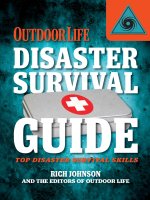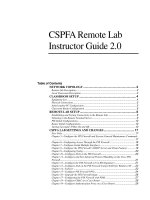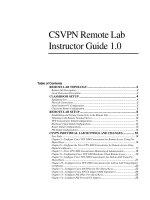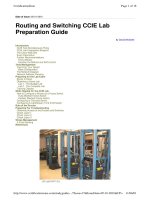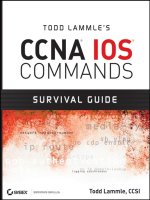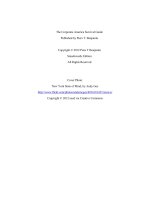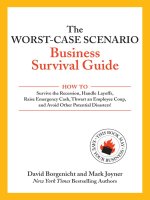james zubrick organic chem lab survival guide [2e ocr]
Bạn đang xem bản rút gọn của tài liệu. Xem và tải ngay bản đầy đủ của tài liệu tại đây (4.85 MB, 346 trang )
The Organic Chem Lab
Survival Manual
A Student's Guide
to Techniques
James W. Zubrick
Hudson Valley Community College
John Wiley
&
Sons
New York • Chichester • Brisbane • Toronto • SingaporeCopyright © 1984,1988, by John Wiley & Sons, Inc.
All rights reserved. Published simultaneously in Canada.
Reproduction or translation of any part of
this work beyond that permitted by Sections
107 and 108 of the 1976 United States Copyright
Act without the permission of the copyright
owner is unlawful. Requests for permission
or further information should be addressed to
the Permissions Department, John Wiley & Sons.
Library of Congress Cataloging-in-Publication Data
Zubrick, James W.
The organic chem lab survival manual.
Includes indexes.
1.
Chemistry, Organic — Laboratory manuals.
I. Title.
QD261.Z83 1988 547'.0078 87-20968
ISBN 0-471-85519-7 (pbk.)
Printed in the United States of America
10 9 8 7 6
Second Edition
It is heartening to hear of your book being read and enjoyed, literally cover to
cover, by individuals ranging from talented high-school science students to
Professors Emeritus of the English language. Even better to hear that you
have a chance to improve that book, based upon the above comments,
comments by reviewers, and the experience gained from working with the
text.
In this edition of The Organic Chem Lab Survival Manual, the section on
notebooks and handbooks have been expanded to include typical notebook
pages and actual handbook entries along with interpretation. There are new
notes on cleaning and drying glassware, and how to find a good recrystalliza-
tion solvent. Once their samples are purified, students may now find direc-
tions for taking a melting point with the Thomas-Hoover apparatus. Wash-
ing has been given the same importance as extraction, and a few more trouble
spots — taking the pH of an organic layer, for one — have been smoothed.
There are additional instructions on steam distillation using external sources
of steam. Simple manometers, coping with air leaks, and the correct use of a
pressure-temperature nomograph enhance the section on vacuum distilla-
tion. Refractometry has been added, as well as—by special request—
sections on the theory of extraction and distillation, including azeotropes and
azeotropic distillation, and, I believe, the first application of the Clausius-
Clapyron equation as a bridge for getting from Raoult's Law (pressure and
mole fraction) to the phase diagram (temperature and mole fraction).
Many people deserve credit for their assistance in producing this edition:
my students, for helping me uncover what was lacking in the previous edition,
with Mr. Ronald Pohadsky and Mr. Barry Eggleston making specific sugges-
tions while working in the laboratory. A special thanks to Professor
G.
J. Janz,
director of the Molten Salts Data Center at the Rensselaer Polytechnic Insti-
tute for his review of the physical chemistry sections of this edition, and to
Professors Henry Hollinger and A. Rauf Imam for their help during the initial
phases of that work. I would also like to thank
William Epstein
University of Utah
Rudolph Goetz
Michigan State University
viii PREFACE
TO THE
SECOND EDITION
Clelia W. Mallory
University of Pennsylvania
J. Wolinsky
Purdue University
for their valuable comments and suggestions in making this edition more
useful for students of organic chemistry laboratory.
Finally, I'd like to thank Mr. Dennis Sawicki, Chemistry Editor at John
Wiley & Sons, first, for one of the nicest birthday presents I've gotten in a
while, and second, for his encouragement, guidance, and patience at some
troubling points in the preparation of this edition. Ms. Dawn Reitz, Produc-
tion Supervisor, Ms. Ann Meader, Supervising Copy Editor, and Mr. Glenn
Petry, Copy Editor deserve a great deal of credit in bringing this second
edition about.
J. W. Zubrick
Hudson Valley Community College
April 3, 1987
Preface to the First Edition
Describe, for the tenth time, an instrument not covered in the laboratory
book, and you write a procedure. Explain, again and again, operations that are
in the book, and you get a set of notes. When these produce questions you
revise until the students, not you, finally have it right. It you believe that
writing is solidified speech—with the same pauses, the same cadences — then
a style is set. And if you can still laugh, you write this book.
This book presents the basic techniques in the organic chemistry labora-
tory with the emphasis of doing the work correctly the first time. To this end,
examples of what can go wrong are presented with admonishments, often
bordering on the outrageous, to forestall the most common of errors. This is
done in the belief that it is much more difficult to get into impossible experi-
mental troubles once the student has been warned of the merely improbable
ones.
Complicated operations, such as distillation and extraction, are dealt
with in a straightforward fashion, both in the explanations and in the se-
quential procedures.
The same can be said for the sections concerning the instrumental tech-
niques of GC, IR, NMR, and HPLC. The chromatographic techniques of GC
and HPLC are presented as they relate to thin-layer and column chromatog-
raphy. The spectroscopic techniques depend less on laboratory manipulation
and so are presented in terms of similarities to the electronic instrumentation
of GC and HPLC techniques (dual detectors, UV detection in HPLC, etc.).
For all techniques, the emphasis is on correct sample preparation and correct
instrument operation.
Many people deserve credit for their assistance in producing this textbook.
It has been more than a few years since this book was first written, and a list of
acknowledgements would approach the size of a small telephone directory —
there are too many good people to thank directly.
For those who encouraged, helped, and constructively criticized, thanks for
making a better book that students enjoy reading and learning from.
I'd like to thank the hundreds of students who put up with my ravings,
rantings, put-ons, and put-downs, and thus taught me what it was they
needed to know, to survive organic chemistry laboratory.
A special thanks to Dr. C.W. Schimelpfenig, for encouragement over many
years when there was none, and whose comments grace these pages; Dr. D.L.
Carson, whose comments also appear, for his useful criticism concerning the
x PREFACE
TO THE
FIRST EDITION
presentation; Drs. R.A. Bailey, S.C. Bunce, and H.B. Hollinger for their
constant support and suggestions; Dr. Mark B. Freilich, whose viewpoint as
an inorganic chemist proved valuable during the review of manuscript; and
Dr. Sam Johnson, who helped enormously with the early stages of the text
processing. I also thank Christopher J. Kemper and Keith Miller for their
valuable comments on the instrumental sections of the book.
Finally, I'd like to thank Clifford W. Mills, my patron saint at John Wiley &
Sons,
without whose help none of this would be possible, and Andrew E. Ford,
Jr., vice president, for a very interesting start along this tortured path to
publication.
Some Notes on Style
It is common to find instructors railing against poor usage and complaining
that their students cannot do as much as to write one clear, uncomplicated,
communicative English sentence. Rightly so. Yet I am astonished that the
same people feel comfortable with the long and awkward passive voice, the
pompous "we" and the clumsy "one," and that damnable "the student," to
whom exercises are left as proofs. These constructions, which appear in
virtually all scientific texts, do not produce clear, uncomplicated, communi-
cative English sentences. And students do learn to write, in part, by following
example.
I do not go out of my way to boldly split infinitives, nor do I actively seek
prepositions to end sentences with. Yet by these constructions alone, I may be
viewed by some as aiding the decline in students' ability to communicate.
E.B.
White, in the second edition of The Elements of Style (Macmillan,
New York, 1972, p. 70), writes
Years ago, students were warned not to end a sentence with a preposi-
tion; time, of course, has softened that rigid decree. Not only is the
preposition acceptable at the end, sometimes it is more effective in that
spot than anywhere else. "A claw hammer, not an axe, was the tool he
murdered her with." This is preferable to "A claw hammer, not an ax, was
the tool with which he murdered her."
Some infinitives seem to improve on being split, just as a stick of round
stovewood does. "I cannot bring myself to really like the fellow." The
sentence is relaxed, the meaning is clear, the violation is harmless and
scarcely perceptible. Put the other way, the sentence becomes
stiff,
need-
lessly formal. A matter of ear.
We should all write as poorly as White.
With the aid of William Strunk and E.B. White in The Elements of Style
and that of William Zinsser in On Writing Well, Rudolph Flesch in The ABC
of Style, and D.L. Carson, whose comments appear in this book, I have tried to
follow some principles of technical communication lately ignored in scientific
texts:
use the first person, put yourself in the reader's place, and, the best for
last, use the active voice and a personal subject.
xii SOME NOTES ON STYLE
The following product names belong to the respective manufacturers. Regis-
tered trademarks are indicated here, as appropriate; in the text, the symbol is
omitted.
Corning® Corning Glass Works, Corning, New York
Drierite® W. A. Hammond Drierite Company, Xenia, Ohio
Fisher-Johns® Fisher Scientific Company, Pittsburgh, Pennsylvania
Luer-Lok® Becton, Dickinson and Company, Rutherford, New
Jersey
Mel-Temp® Laboratory Devices, Cambridge, Massachusetts
Millipore® Millipore Corporation, Bedford, Massachusetts
Swagelok® Crawford Fitting Company, Solon, Ohio
Teflon® E.I. DuPont de Nemours & Company, W
:
lmington,
Delaware
Variac® General Radio Company, Concord, Massachusetts
Forewords
Seldom does one have the opportunity to read and use a textbook that is
completely useful, one that does not need substitutions and deletions. Zu-
brick's book is this type of resource for undergraduate organic students and
their laboratory instructors and professors. I must heartily recommend this
book to any student taking the first laboratory course in organic chemistry.
The Organic Chem Lab Survival Manual is filled with explanations of
necessary techniques in much the same way that advanced techniques have
been presented in books by Wiberg, Lowenthal, Newman, and Gordon and
Ford. In larger universities, The Survival Manual is a valuable supplement to
most laboratory manuals. It provides explanations that many graduate
teaching assistants do not take time to give to their classes. Most teaching
assistants of my acquaintance appreciate Zubrick's book because it supports
their discussions during recitations (when each student has a personal copy),
and it refreshes their memories of good techniques they learned and must pass
on to a new generation of undergraduates.
The book is addressed to the undergraduate student audience. The infor-
mal tone appeals to most laboratory students. The illustrations are delightful.
The use of different type fonts is effective for emphasis. Also, Zubrick always
explains why the particular sequence of operations is necessary, as well as how
to manipulate and support the apparatus and substances. This is a definite
strength.
This book is an evolutionary product: Over the span of a decade, professors
at major universities and liberal arts colleges have made suggestions for
minor changes and improvements. I count myself fortunate to have used the
forerunners, which have been published since 1973.
A large quantity of useful information has been collected, well organized,
and presented with great care. This book is the handiwork of a master teacher.
C.W. Schimelpfenig
Dallas Baptist University
Dallas, Texas
The
Organic
Chem Lab Survival Manual is a book I have known about for a
number of years in a variety of developmental stages. As it progressed, I
watched with interest as Jim Zubrick struggled to achieve a balance between
merely conveying information—what most books do — and conveying that
xiv FOREWORDS
information efficiently
to its
very human audience.
On the one
hand,
Jim
insisted that
his
book contain
all the
necessary scientific detail;
on the
other
hand,
he
also insisted that
a "how to"
book
for
organic chemistry
lab
need
not
be written
in the
dull
and
confusing prose which
so
often passes
as the
lingua
franca
of
science. This book demonstrates that
he has
achieved both goals
in
admirable fashion.
In fact,
The
Survival Manual succeeds very well
in
following Wittgenstein's
dictum that "everything that
can be
thought
at all, can be
thought clearly.
Anything that
can be
said
can be
said clearly."
It
also follows
the
advice
of
Samuel Taylor Coleridge
to
avoid pedantry
by
using only words "suitable
to
the time, place,
and
company."
Although some
few
readers
may
take umbrage with this book because
it is
not, atypically couched
in the
language
of a
typical journal article, similar
people
no
doubt also complained when William Strunk published Elements of
Style
in 1919. For
Strunk also broke with tradition. Most other writing texts
of
the day
were written
in the
convoluted language
of the
nineteenth century,
and
the
material they contained consisted largely
of
lists
of
arcane practices,
taboos,
and
shibboleths
— all
designed
to
turn students into eighteenth-cen-
tury writers.
From Strunk's point
of
view, such texts were less than desirable
for
several
major reasons. First,
the
medicine they offered students
had
little
to do
with
the communication process
itself;
second,
it had
little
to do
with current
practice;
and
third, taking
the
medicine
was so
difficult that
the
cure created
more distress
in the
patients than
did the
disease
itself.
Jim Zubrick proves
in
this book that
he
understands,
as did
Strunk, that
learning reaches
its
greatest efficiency
in
situations where only that informa-
tion
is
presented which
is
directly related
to
completing
a
specific task.
In an
environment fraught with hazards, efficiency
of
this sort becomes even more
necessary.
The Survival Manual
is an
excellent book because
it
speaks
to its
audience's
needs.
Always direct —
if
sometimes slightly irreverent —
the
book says
clearly what many other books only manage
to say
with reverent indirection.
It never forgets that time
is
short
or
that
the
learning curve rises very slowly
at
first.
The
prose
is
straightforward, easy
to
understand,
and is
well supported
by plentiful illustrations keyed
to the
text.
It is
also technically accurate
and
technically complete,
but it
always explains matters
of
laboratory technology
in
a way
designed
to
make them easily understandable
to
students
in a
func-
tional context.
All
of
these characteristics related
to
communication efficiency will natu-
FOREWORDS
xv
rally make the laboratories in which the book is used safer labs; the improved
understanding they provide serves as natural enhancement to the book's
emphatic and detailed approach to laboratory safety.
Most important, however, all the elements of The Survival Manual come
together in focusing on the importance of task accomplishment in a way
which demonstrates the author's awareness that communication which does
not efficiently meet the needs of its audience is little more than pedantry
unsuitable to the time, place, and company.
David L. Carson
Director,
The Master of Science
Program in Technical Communication
Rensselaer Polytechnic Institute
1.
Safety First, Last, and Always 1
Accidents Will Not Happen 5
2.
Keeping A Notebook 7
A Technique Experiment 9
Notebook Notes 9
A Synthesis Experiment 9
Notebook Notes 13
3. Interpreting A Handbook 21
CRC Handbook 22
Entry: 1-Bromobutane 22
Entry: Benzoic Acid 25
Nostalgia 25
Lange's 27
Entry: 1-Bromobutane 28
Entry: Benzoic Acid 30
Merck Index 32
Entry: 1-Bromobutane 32
Entry: Benzoic Acid 33
The Aldrich Catalog 35
Entry: 1-Bromobutane 36
Entry: Benzoic Acid 37
Not Clear—Clear? 37
4. Jointware 39
Stoppers with Only One Number 40
Another Episode of Love of Laboratory 41
Hall of Blunders and Things Not Quite Right 44
Round-Bottom Flasks 44
Columns and Condensers 44
The Adapter With Lots of Names 45
Forgetting The Glass 47
xviii
Inserting Adapter Upside Down
Inserting Adapter Upside Down Sans Glass
Greasing the Joints
To Grease or Not To Grease
Preparation of the Joints
Into the Grease Pit
Storing Stuff
and
Sticking Stoppers
Corking
a
Vessel
The Cork Press
CONTENTS
48
49
49
49
50
50
50
52
53
5. Other Interesting Equipment 55
6. Clean and Dry 59
Drying Your Glassware When You Don't Need To 60
Drying Your Glassware When You Need To 61
7. Drying Agents 63
Typical Drying Agents 64
Using a Drying Agent 65
Following Directions and Losing Product Anyway 66
8. On Products 67
Solid Products 68
Liquid Products 68
The Sample Vial 69
Hold It! Don't Touch that Vial 69
9.
The Melting Point Experiment 71
Sample Preparation 73
Loading the Melting Point Tube 73
Closing Off Melting Point Tubes 75
Melting Point Hints 75
The Mel-Temp Apparatus 76
Operation of the Mel-Temp Apparatus 77
The Fisher-Johns Apparatus 78
Operation of the Fisher—Johns Apparatus 79
The Thomas-Hoover Apparatus 80
CONTENTS xix
Operation of the Thomas - Hoover Apparatus 82
Using the Thiele Tube 85
Cleaning the Tube 87
Getting the Sample Ready 87
Dunking the Melting Point Tube 87
Heating the Sample 88
10.
Recrystallization 91
Finding a Good Solvent 93
General Guidelines for a Recrystallization 94
Gravity Filtration 95
The Buchner Funnel and Filter Flask 98
Just a Note 100
Activated Charcoal 100
The Water Aspirator: A Vacuum Source 101
The Water Trap 102
Working with a Mixed-Solvent System—
The Good Part 103
The Ethanol - Water System 103
A Mixed-Solvent System—The Bad Part 105
Salting-Out 106
World Famous Fan-Folded Fluted Filter Paper 107
11.
Extraction and Washing 111
Never-Ever Land 113
Starting an Extraction 113
Dutch Uncle Advice 115
The Separatory Funnel 116
The Stopper 116
The Glass Stopcock 116
The Teflon Stopcock 118
The Stem 119
Washing and Extracting Various Things 120
How To Extract and Wash What 120
The Road to Recovery—Back-Extraction 122
A Sample Extraction 123
Performing an Extraction or Washing 125
Extraction Hints 127
XX
12.
And Now—Boiling Stones 129
13.
Sources of Heat 131
The Steam Bath 132
The Bunsen Burner 133
Burner Hints 135
The Heating Mantle 136
Proportional Heaters and Stepless Controllers 137
14.
Clamps and Clamping 143
Clamping a Distillation Setup 146
15.
Distillation 151
Distillation Notes 153
Class 1: Simple Distillation 153
Sources of Heat 153
The 3-Way Adapter 153
The Distilling Flask 154
The Thermometer Adapter 156
The Ubiquitous Clamp 156
The Thermometer 156
The Condenser 156
The Vacuum Adapter 156
The Receiving Flask 157
The Ice Bath 157
The Distillation Example 157
The Distillation Mistake 158
Class 2: Vacuum Distillation 159
Pressure Measurement 159
Manometer Hints 160
Leaks 162
Pressure and Temperature Corrections 163
Vacuum Distillation Notes 167
Class 3: Fractional Distillation 169
How this Works 170
Fractional Distillation Notes 172
Azeotropes 173
xxi
Class 4: Steam Distillation 174
External Steam Distillation 175
Internal Steam Distillation 176
Steam Distillation Notes 176
16.
Reflux 179
A Dry Reflux 181
Addition and Reflux 183
Funnel Fun 184
How to Set Up 184
17.
Sublimation 189
18.
Chromatography: Some Generalities 193
Adsorbents 194
Separation or Development 194
The Eluatropic Series 195
19.
Thin-Layer Chromatography: TLC 197
Preparation of TLC Plates 198
The Plate Spotter 200
Spotting the Plates 200
Developing a Plate 201
Visualization 203
Interpretation 204
Multiple Spotting 207
Preparative TLC 208
20.
Wet-Column Chromatography 209
Preparing the Column 210
Compounds on the Column 212
Visualization and Collection 213
21.
Dry Column Chromatography 217
xxii
22.
Refractometry 221
The Abbe Refractometer 223
Using the Abbe Refractometer 224
Refractometry Hints 226
23.
Instrumentation in the Lab 227
24.
Gas Chromatography 229
The Mobile Phase: Gas 230
GC Sample Preparation 230
GC Sample Introduction 231
Sample in the Column 233
Sample at the Detector 234
Electronic Interlude 236
Sample on the Chart Recorder 237
Parameters, Parameters 238
Gas Flow Rate 238
Temperature 239
25.
HP Liquid Chromatography 241
The Mobile Phase: Liquid 242
A Bubble Trap 244
The Pump 245
The Pulse Dampener 245
HPLC Sample Preparation 247
HPLC Sample Introduction 248
Sample in the Column 249
Sample at the Detector 250
Sample on the Chart Recorder 251
Parameters, Parameters 251
Eluent Flow Rate 252
Temperature 252
Eluent Composition 252
26.
Infrared Spectroscopy 253
Infrared Sample Preparation 258
Liquid Samples 259
xxiii
Solid Samples 260
TheNujol Mull 260
Solid KBr Methods 262
Preparing the Solid Solution 262
Pressing a KBr Disk — The Mini-Press 262
Pressing a KBr Disk — The Hydraulic Press 262
Running the Spectrum 265
The Perkin - Elmer 71
OB
IR 267
Using the Perkin - Elmer 71
OB
269
The 100% Control: An Important Aside 269
Calibration of the Spectrum 272
IR Spectra: The Finishing Touches 272
Interpreting IR's 275
27.
Nuclear Magnetic Resonance (NMR) 277
Liquid Sample Preparation 278
Solid Samples 280
Protonless Solvents 280
Deuterated Solvents 280
Some NMR Interpretation 281
The Zero Point 281
The Chemical Shift 281
Some Anisotropy 284
Spin-Spin Splitting 285
Integration 287
28.
Theory of Distillation 289
Class 1: Simple Distillation 290
Clausius & Clapyron 292
Class 3: Fractional Distillation 294
A Hint from Dalton 294
Dalton and Raoult 295
A Little Algebra 296
Clausius and Clapyron Meet Dalton and Raoult 296
Dalton Again 298
What Does It All Mean? 299
Reality Intrudes I: Changing Composition 303
xxiv
Reality Intrudes II: Nonequilibrium Conditions 304
Reality Intrudes III: Azeotropes 304
Minimum-Boiling Azeotropes 305
Maximum-Boiling Azeotropes 306
Azeotropes on Purpose-Azeotropic Distillation 306
Other Deviations 307
Class 4: Steam Distillation 307
29.
Theory of Extraction 311
Safety
First,
Last
and
Always


